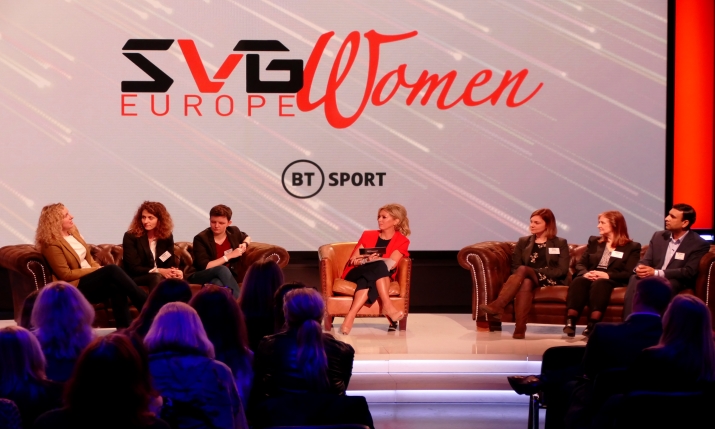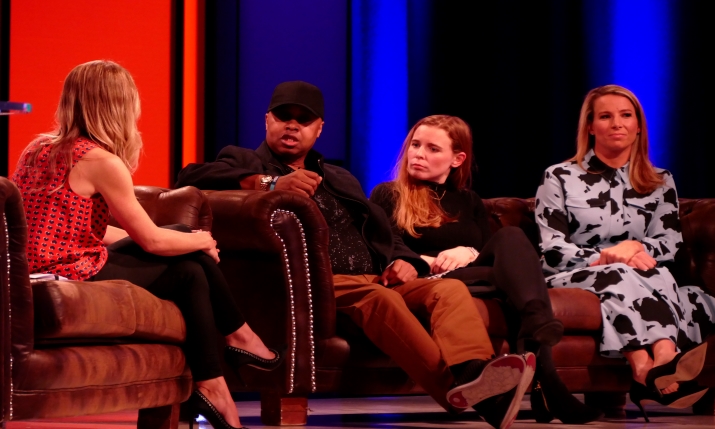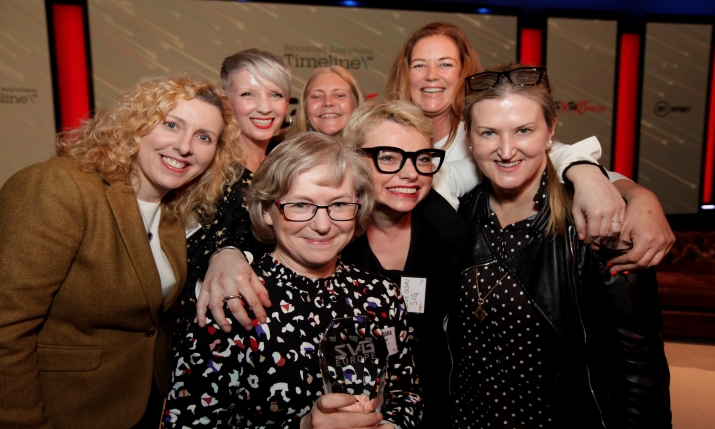International Women’s Day 2020: Solving inequality with goals, targets and action
Part 3 in our International Women’s Day special

Making plans to bring more women into technical engineering courses and roles within sports broadcasting on the Engineers V Educators panel at SVG Europe Women’s Winter Networking Event 2020, at BT Sport with Timeline TV, chaired by sports presenter, Sarra Elgan
Solving diversity and inclusion challenges within the sports broadcasting industry requires planning, goals, targets, actions and measurement. As International Women’s Day 2020 flags up the role and need for women in the workplace, it is time to look at how the those in this industry can make positive steps towards making that happen.
For those women already working in sports broadcasting, frustrations abound. However, Telstra Broadcast Services’ Anna Lockwood, head of global sales, states: “We have made important progress in raising awareness on the importance of diversity in sports broadcasting, but there is still so much further to go. Diversity is still a challenge in our technical, operational, creative and executive teams. It is also a challenge at our industry events, representation on panels and speaking engagements, and on our industry bodies and boards.”
Anna Ward, Premier League Productions head of production, says the most frustrating thing she sees in sports broadcasting on a regular basis is, from a diversity and inclusion perspective, “that the lack of diversity within the industry is the under-represented groups’ problem to solve”.
She continues: “Business leaders need to engage with the conversation and understand that their businesses will get left behind if they don’t start to address the issue.”
Jennifer Angell, industry consultant, comments on the areas that she finds most perplexing in the sports broadcasting industry: “I would have to say undermining is really frustrating and demoralising; anyone talking over someone else while they have the floor is not only frustrating but totally disrespectful to your colleague.”
While on frustrations in sports broadcasting on camera, she adds, “I would say that we need more diversity, and by that I mean BAME people and women”.

On the Abi Stephen’s Show panel at the SVG Europe Women Winter Networking Event, panelists discuss role models and how to bring more women and BAME people into this industry
No need to justify
Lise Cosimi, industry consultant and external head of the SVG Europe Women Advisory Board, says being judged as ‘less than’ because she is female is an ongoing issue: “I still get asked if I have the experience to do the job! I find it very irritating having to justify myself all the time. Also, when I am with a group of men-only, I find myself ignored.”
Claudia Corbisiero, producer at Noah Media Group, agrees, looking at the area of football: “I think it would be the assumption that women aren’t able to analyse the men’s game or give their perspective because they’ve never played in the Premier League. Many commentators, producers, analysts and directors haven’t played at this level either and yet they are entitled to an opinion that is respected. The myth that women don’t know as much about sport as men needs to stop.”
Paula Rigby, Noah Media Group head of international production development, comments on what irritates her in this industry: “Too many men in our industry who don’t attend or don’t think it’s worth them attending key women’s networking events, like the one recently held at BT Sport by SVG Europe Women, or even to see it as valuable to their day to day business or working relationships.
“It’s frustrating that I know many men in senior positions who could make a difference by listening to personal stories of women currently in our industry and the issues they face,” she continues. “It would help them understand how to retain key staff. It would also help them to understand the challenges we now face in attracting young women and those from diverse backgrounds to join the sports broadcasting industry.”
Rigby adds: “I have two ideas why I think some men think like this: they’re genuinely afraid to be in a room with so many women, who might have questions or opinions; or an even sadder fact is they’re apathetic. Either way they need to ‘grow a pair’…of eyes!”
Rigby concludes: “I’ve been outnumbered by men over the years. I didn’t flinch although at times it was unnerving, but I love the industry and the work we produce so I just got on with it. I can’t understand why some men don’t embrace the change and see it as an opportunity to move their business forward.”
Anything is possible
Angela Gibbons, CTV Outside Broadcasts commercial manager, says her greatest frustration is people, “not having a ‘can do’ attitude”. She goes on: “Anything and everything is possible, if you have vision. As ever, good leadership and direction is important, but still the vision or the dream to achieve and to make a difference needs to come first. Vision, self-belief and communicating with like-minded individuals breeds confidence and success.”
While Lockwood notes that, “the goal for all of us should be that equity and equality of opportunity are the benchmark for our industry”.
She goes on: “We should consciously look for and embrace strategies to work towards a future where we have a stronger and better industry that fully represents and reflects the diversity of our business. Diversity is essential for innovation, for audience and fan engagement, and for our work culture. It helps improve our creative and business results, helps enhance our reputation, and helps attract, engage and retain talented people.
“I love the sports broadcasting industry, and I have had a wonderful career working in sports and technology. I want to make sure that we create the conditions where any woman can successfully join our industry and then continue to thrive in a career in sports broadcasting,” concludes Lockwood.

Some members of the SVG Europe Women Advisory Board present at the Winter Networking Event 2020, alongside winner of the SVG Europe Women Achievement Award 2020, Barbara Slater, BBC Sport director [foreground, and left to right: Roisin McKeniry, Timeline TV; Heather McLean, SVG Europe; Anna Lockwood, Telstra; Lise Cosimi, industry consultant; Paula Rigby, Noah Media Group; and Jennifer Angell, industry consultant]
So how can we make the change that is needed in sports broadcasting? On how we can get more diversity and inclusivity in sports broadcasting, Inga Ruehl, Sky Sports executive director, production services and operations, says: “There is no easy fix for that. We have to do the hard work and hard graft because you can’t just pay lip service to increasing diversity and inclusion in sports broadcasting overall.
“You need to set clear goals and targets of what you are trying to achieve and then come up with a plan on how to achieve it,” Ruehl advises. “You need to sort out your talent pipelines, starting at entry level but working your way up through your organisation. You need to be brave and think differently about what you need when recruiting; would the team benefit more from different viewpoints and approaches, rather than the obvious candidate that you would have appointed or promoted in the past would bring. Take some risks and show your teams you mean it,” she concludes.
Corbisiero adds: “As much as sports broadcasting’s audience needs to be reflected and represented in the industry, there also needs to be a push from the top to consider diversity when hiring. Candidates should obviously be selected on merit, but you would hope that senior management asks the question: “Does our staff represent a range of backgrounds and genders, and therefore a range of different perspectives?” Seeing more diversity on screen and behind the scenes will help women and BAME to imagine themselves doing these roles.”
Inclusive cultures
To bring more women and BAME people into sports broadcasting, Ward says, “the focus, in my opinion, needs to be on creating an inclusive culture”. However, she goes on: “That’s not easy! And can’t be achieved by siloing off the problem to be solved by those it impacts on most. It needs to be addressed by business leaders fully engaging with the issue and working to change their business practices so they become more inclusive.”
Ward adds: “They need to look at how they are recruiting and promoting within their companies. They need to look at what behaviours are being rewarded and how individuals engage and network with one another. If any of those things aren’t being done with inclusivity in mind, they need to change those practices and behaviours.”
Looking at diversity and inclusivity in sports broadcasting overall, in front of and behind the cameras, Lockwood says: “Consistent, proactive activity and attention to attracting diverse talent is important, and then promoting an inclusive culture and flexible working conditions is increasingly key to retaining and supporting that talent.
“Technology is helping with this, as different employment models are becoming more common through the use of new office and communication technology and new production workflows (remote working, centralised working, part time work, job-sharing),” Lockwood notes. “Metrics and reporting are important; at Telstra Broadcast Services we track diversity metrics and regularly report on them, and this has helped with awareness and a higher motivation to recruit, retain and promote a diverse workforce. We also have diversity targets throughout the talent management chain: for initial interviews, shortlisted candidates, new recruits, the overall workforce and our executive team. We track and report on these metrics and we have seen the positive impact on our business from this focused approach on talent management.
“And finally, allyship is an important concept for all of us to embrace,” adds Lockwood. “Whatever our gender, role, or contribution to the business, we can all be allies to promote a diverse and inclusive culture in our sports broadcasting industry.”
Practical actions
As to making sure people know what jobs are available in this industry, Kylie Jenner, freelance director, comments: “Visibility is key. I think we are achieving that on screen but behind the scenes people often don’t know what jobs are involved in the making of a broadcast.”
She continues: “There is a lack of information; a quick search of the internet will show that most of the jobs within sports broadcasting are not mentioned, let alone explained. How is a young person supposed to know what fits them if they have no idea the job exists? As an industry we should be shouting about what is available and show that anybody is capable of doing a job that suits their skill set.”
Gibbons says the answer to letting women and girls know what jobs are available to them in this industry is, “by breaking down barriers, going into schools and colleges, letting everyone know their voice and their participation counts”.
Continuing, Gibbons says: “For many years sports broadcasting was perceived as being exclusive and unobtainable to many, but advances in technology and the breaking down of older barriers and taboos means that there are opportunities for all, ie, there is only one criteria; if you have talent, your sports broadcaster wants you!”
Meanwhile, Cosimi notes: “Training is number one, especially for women already in the industry. We also need to be looking at orientation sessions, opening the doors for visits to schools, and for young girls at school level to try out internships to see what it is like to be working in this industry. We also need to change the law to help protect women’s rights, as being freelance does not protect women, and if they have to choose between kids and work, they will chose family over career.”
Angell concludes with what needs to keep happening to help push women in sports broadcasting forward: “SVG Europe and SVG Europe Women have curated great events for the industry. There are many outreach programmes attracting students and those who want to learn more about sports broadcasting. More of this!”
